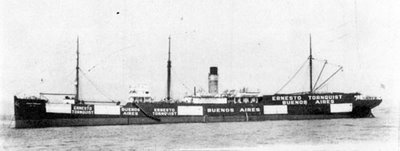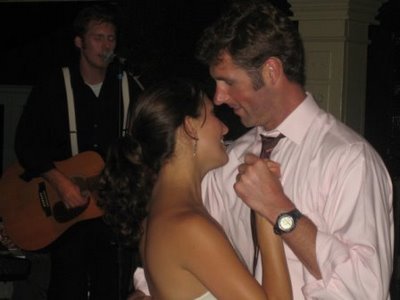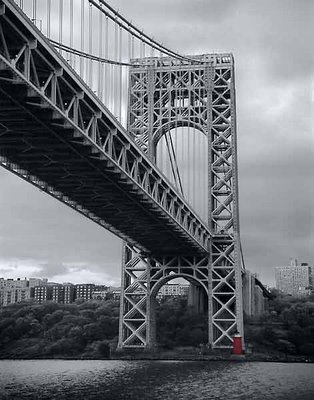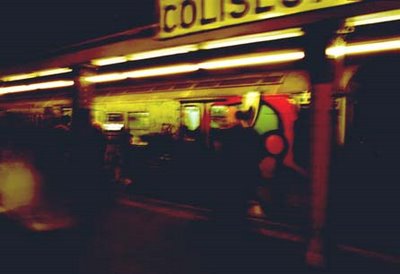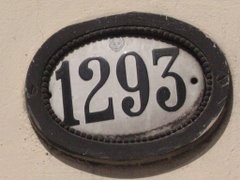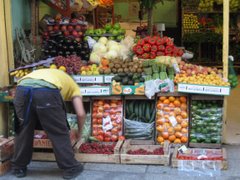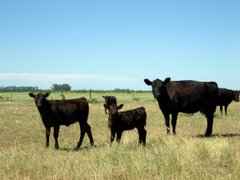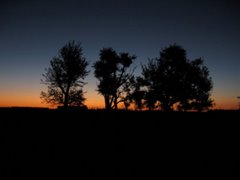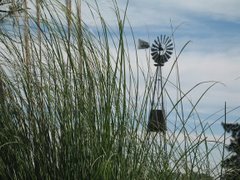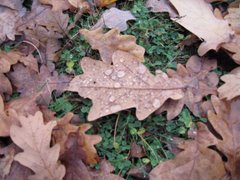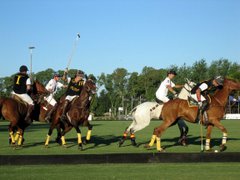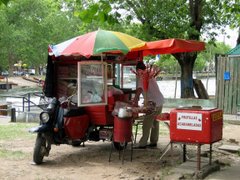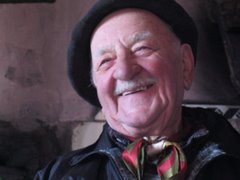
I'm shown into the office on Cordoba and there behind the desk is someone who must be Dora. There is a commotion going on. She has slid her chair over to the fax machine and seems to be in a desperate struggle to remove a toner cartridge. The receiver is wedged up to her ear and she is shouting at someone over the phone line. She tells the person to hold and yells for her assistant. He leans in and she sends him out to buy a roll of fax paper.
I expect that after a while she will stand up or lean forward for the usual greeting - the kiss on the cheek. Instead Dora doesn't acknowledge my presence. She takes a drag of her cigarette and a swig of coffee and goes back to her conversation.
I have time to look around.
The fax machine, circa 1986, is the only sign of change in the office, circa 1950. On her desk there is a old three-line office phone and that's it. No computer to be seen. There are stacks of papers around the phone and in the little bookcase along the wall. The walls have never been repainted, but there is a picture of the Casa Rosada or maybe the Obelisco which stands a few blocks away.
The assistant returns quickly with the roll of fax paper and gets the machine up and running again. The crisis is over for now and Dora finally turns her attention to me. She looks as battle-hardened as her smokey-voice sounds, but she seems like a good person and I like her right away.
I expect that after a while she will stand up or lean forward for the usual greeting - the kiss on the cheek. Instead Dora doesn't acknowledge my presence. She takes a drag of her cigarette and a swig of coffee and goes back to her conversation.
I have time to look around.
The fax machine, circa 1986, is the only sign of change in the office, circa 1950. On her desk there is a old three-line office phone and that's it. No computer to be seen. There are stacks of papers around the phone and in the little bookcase along the wall. The walls have never been repainted, but there is a picture of the Casa Rosada or maybe the Obelisco which stands a few blocks away.
The assistant returns quickly with the roll of fax paper and gets the machine up and running again. The crisis is over for now and Dora finally turns her attention to me. She looks as battle-hardened as her smokey-voice sounds, but she seems like a good person and I like her right away.
I hand over my birth certificate(registro civil)and an old passport. She considers these and rapidly describes the steps that will have to be taken. I pick up every third or fourth word. She seems to be saying that any official record of my birth is definitely gone goodbye. The only thing we have to work with is that piece of paper. For some reason the passport is useless and she hands it back to me.
Anyone could see after two minutes that Dora kicks butt and gets results. And that's why I'm here. Dora is going to walk me through Argentina's epic bureaucracy. She's the best gestora in town. Think you're smart enough, charming enough, or resilient enough to wade into a Argentine goverment office on your own and come out with whatever important documentation you need? Forget it. Better call old Dora. She knows how to plow through paperwork backlogs, missing files, change in procedure, take a number, closing at 3:00pm, on vacation, that office moved, come back when you have 5 copies of X or the proper forms Y and Z. Dora knows overworked and underpayed functionaries and clerks and works them until they bend to her will.
I go away feeling confident.
But my case is a difficult one and even Dora struggles to make progress. After a few weeks she calls and says to stop by on a Saturday and leave $200 pesos with the guard. He will give me a receipt. I tell this to various people and they all agree that this is coima for someone(a bribe). When I show up on Saturday the guard is out to lunch. I wait for more than an hour while he enjoys his 5-course meal and a siesta. A second-rate modeling school in the building is holding auditions and that keeps things interesting. Finally the guard shows up and starts digging around in his desk for the receipt. He can't find it but I see it there under his nose. The transaction is finally completed.
After a few more weeks I hear from Dora that plan A has apparently failed. Now I am to meet her at the neighborhood civil office in an end-run on the national register. At the civil office we wait for our number to be called. As usual there are no computers to be seen. The woman tells us we're in the wrong place. They debate back and forth. Dora gets her turned around. OK, where are the photographs? We don't have them. We run down the street to a photography studio. It's closed. A sign on the door says check the cafe on the corner. Dora finds him and hauls him back to work against his will. He puts on tango. First things first. He tells a few stories. I'm thoroughly enjoying myself. Dora tries to hurry him along. He finally takes the pictures and we go back. A flurry of stamps and signatures and paperwork. The woman inks up all 10 of my fingers with a huge ink pad and makes 10 prints on a form. They send me to the men's room to wash up. The sink is covered with ink stains.
About a month later we make arrangements to meet at another office. Here I am to get the long awaited DNI. We are at a little known auxiliary branch of a forgotten department of the national register. We are sent up to the 6th floor. Wrong floor. Someone tells us to go down to 5. Someone on 5 tells us to go down to 3. On 3 we are sent through an interior office and out across a courtyard to another building. In this office there are stacks of blank ID cards and handwritten forms. We finally find the office in question and the woman comes out to the hallway to meet us. She asks for a photograph. Dora looks surprised. Luckily I have the last one with me. After a while we are called in. I sign the handwritten ID. The woman sticks the photo in the right place and laminates it. She shakes my hand. That's it. I have Argentine citizenship again.
Back out in the hallway I pay Dora and she gives me her new business card. We say goodbye forever.
I go away feeling confident.
But my case is a difficult one and even Dora struggles to make progress. After a few weeks she calls and says to stop by on a Saturday and leave $200 pesos with the guard. He will give me a receipt. I tell this to various people and they all agree that this is coima for someone(a bribe). When I show up on Saturday the guard is out to lunch. I wait for more than an hour while he enjoys his 5-course meal and a siesta. A second-rate modeling school in the building is holding auditions and that keeps things interesting. Finally the guard shows up and starts digging around in his desk for the receipt. He can't find it but I see it there under his nose. The transaction is finally completed.
After a few more weeks I hear from Dora that plan A has apparently failed. Now I am to meet her at the neighborhood civil office in an end-run on the national register. At the civil office we wait for our number to be called. As usual there are no computers to be seen. The woman tells us we're in the wrong place. They debate back and forth. Dora gets her turned around. OK, where are the photographs? We don't have them. We run down the street to a photography studio. It's closed. A sign on the door says check the cafe on the corner. Dora finds him and hauls him back to work against his will. He puts on tango. First things first. He tells a few stories. I'm thoroughly enjoying myself. Dora tries to hurry him along. He finally takes the pictures and we go back. A flurry of stamps and signatures and paperwork. The woman inks up all 10 of my fingers with a huge ink pad and makes 10 prints on a form. They send me to the men's room to wash up. The sink is covered with ink stains.
About a month later we make arrangements to meet at another office. Here I am to get the long awaited DNI. We are at a little known auxiliary branch of a forgotten department of the national register. We are sent up to the 6th floor. Wrong floor. Someone tells us to go down to 5. Someone on 5 tells us to go down to 3. On 3 we are sent through an interior office and out across a courtyard to another building. In this office there are stacks of blank ID cards and handwritten forms. We finally find the office in question and the woman comes out to the hallway to meet us. She asks for a photograph. Dora looks surprised. Luckily I have the last one with me. After a while we are called in. I sign the handwritten ID. The woman sticks the photo in the right place and laminates it. She shakes my hand. That's it. I have Argentine citizenship again.
Back out in the hallway I pay Dora and she gives me her new business card. We say goodbye forever.
Over the last 6 months I've heard her name mentioned repeatedly. I'm surprised to learn that she now has a web site. The site looks good and there is a choice of 4 different languages.
But only the spanish link works.





